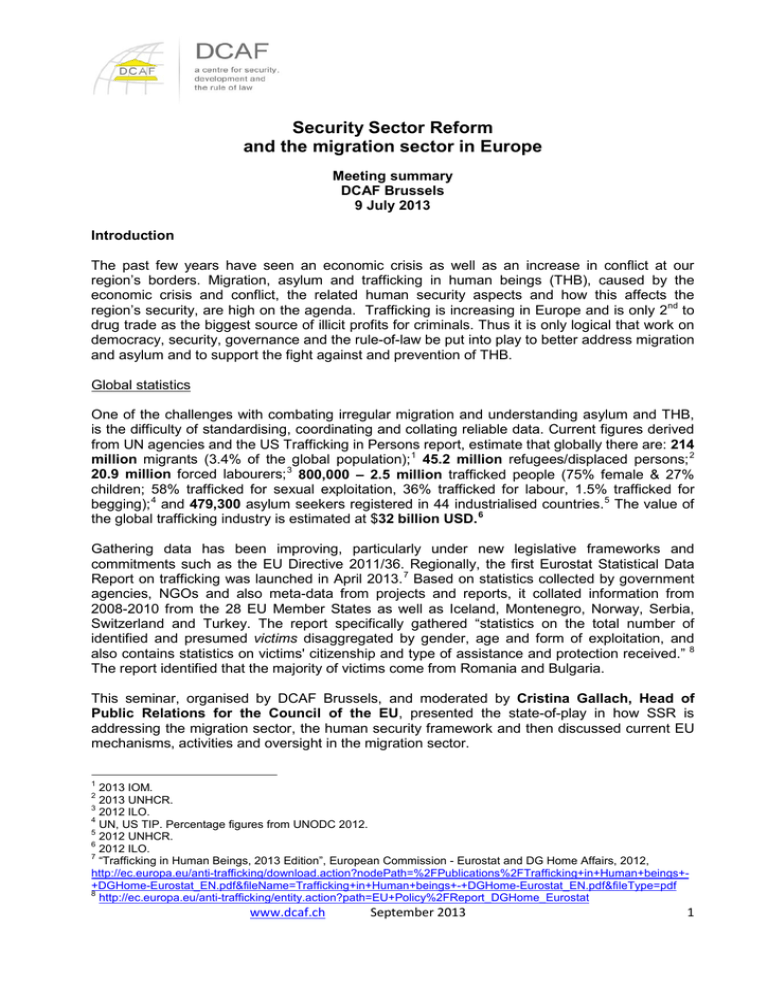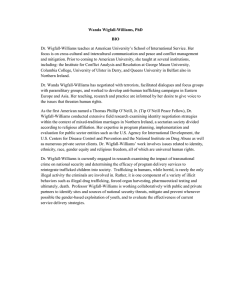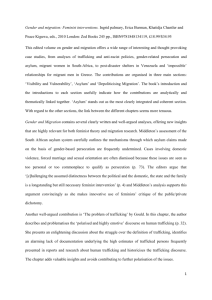
Security Sector Reform
and the migration sector in Europe
Meeting summary
DCAF Brussels
9 July 2013
Introduction
The past few years have seen an economic crisis as well as an increase in conflict at our
region’s borders. Migration, asylum and trafficking in human beings (THB), caused by the
economic crisis and conflict, the related human security aspects and how this affects the
region’s security, are high on the agenda. Trafficking is increasing in Europe and is only 2nd to
drug trade as the biggest source of illicit profits for criminals. Thus it is only logical that work on
democracy, security, governance and the rule-of-law be put into play to better address migration
and asylum and to support the fight against and prevention of THB.
Global statistics
One of the challenges with combating irregular migration and understanding asylum and THB,
is the difficulty of standardising, coordinating and collating reliable data. Current figures derived
from UN agencies and the US Trafficking in Persons report, estimate that globally there are: 214
million migrants (3.4% of the global population); 1 45.2 million refugees/displaced persons; 2
20.9 million forced labourers; 3 800,000 – 2.5 million trafficked people (75% female & 27%
children; 58% trafficked for sexual exploitation, 36% trafficked for labour, 1.5% trafficked for
begging); 4 and 479,300 asylum seekers registered in 44 industrialised countries. 5 The value of
the global trafficking industry is estimated at $32 billion USD. 6
Gathering data has been improving, particularly under new legislative frameworks and
commitments such as the EU Directive 2011/36. Regionally, the first Eurostat Statistical Data
Report on trafficking was launched in April 2013. 7 Based on statistics collected by government
agencies, NGOs and also meta-data from projects and reports, it collated information from
2008-2010 from the 28 EU Member States as well as Iceland, Montenegro, Norway, Serbia,
Switzerland and Turkey. The report specifically gathered “statistics on the total number of
identified and presumed victims disaggregated by gender, age and form of exploitation, and
also contains statistics on victims' citizenship and type of assistance and protection received.” 8
The report identified that the majority of victims come from Romania and Bulgaria.
This seminar, organised by DCAF Brussels, and moderated by Cristina Gallach, Head of
Public Relations for the Council of the EU, presented the state-of-play in how SSR is
addressing the migration sector, the human security framework and then discussed current EU
mechanisms, activities and oversight in the migration sector.
1
2013 IOM.
2013 UNHCR.
3
2012 ILO.
4
UN, US TIP. Percentage figures from UNODC 2012.
5
2012 UNHCR.
6
2012 ILO.
7
“Trafficking in Human Beings, 2013 Edition”, European Commission - Eurostat and DG Home Affairs, 2012,
http://ec.europa.eu/anti-trafficking/download.action?nodePath=%2FPublications%2FTrafficking+in+Human+beings++DGHome-Eurostat_EN.pdf&fileName=Trafficking+in+Human+beings+-+DGHome-Eurostat_EN.pdf&fileType=pdf
8
http://ec.europa.eu/anti-trafficking/entity.action?path=EU+Policy%2FReport_DGHome_Eurostat
2
www.dcaf.ch
September 2013
1
Shifting security – SSR and the migration, asylum and counter-THB sector
Head of the Migration, Asylum and counter-THB Programme at DCAF, 9 Giji Gya, outlined a
framework of human security for the security sector, explained what is security sector – or
system - reform (SSR) and the relationship of SSR to the migration sector (see backgrounder).
She pointed out the challenges that the security sector faces in detection of and understanding
the varied facets of migration (regular, forced, economic, irregular and illegal). Furthermore, that
victims themselves are not always cognisant of their own exploitation. She noted in particular
that “Currently, our security system still does not protect the vulnerable people and even worse,
we still have criminalisation and arrest of, for example, ‘illegal’ migration, victims of exploitation
or circumstance, beggars, those trying to join their family, as their situation is often outside
‘legal’ boundaries.” Ms Gya concluded with examples of SSR - in particular focusing on
responses to counter human trafficking – such as improving training and response of police and
border authorities in capabilities for: recognition of victims, interviewing skills, protecting victims,
confidentiality for victims, cooperation and coordination between agencies (including judicial
structures) and NGOs, and prosecution of traffickers.
EU Developments
From the Office of the EU Anti-Trafficking Coordinator, 10 Ms Zoi Sakelliadou, presented the
latest EU progress in the area of human trafficking, in particular following the EU Directive
2011/36 on preventing and combating trafficking in human beings and protecting its victims, 11
which focuses on a human rights and gender approach. The Directive, despite support and
being adopted in March 2011, still only has nine EU member states that have transposed it into
national legislation. The complementary EU strategy towards eradication of THB 2012-2016, 12
emphasises a victim and child centred approach, as well as a multi-disciplinary involvement of
diverse actors. Ms. Sakelliadou noted the priorities for the EU of: protection, prevention,
prosecution (of traffickers), coordination/cooperation and increasing knowledge on trafficking in
human beings. In 2014, the office will submit a report to the European Parliament and Council
on progress and the following year, the Commission will assess progress of member states to
implement compliance with the Directive. There is also targeted EU funding to combat
trafficking, including a mapping by the Commission of the effectiveness of funding distributed so
far. Finally the Office has coordinated the launching of a new civil-society platform on antitrafficking. Ms. Sakelliadou also noted the list of priority third countries: Albania, Brazil, China,
Dominican Republic, Morocco, Nigeria, Russian Federation, Turkey, Ukraine and Vietnam,
which are sources of the most identified non-EU traffickers and victims in the EU.
Trafficking of children - a human security perspective
A zero tolerance policy must be established internationally vis-à-vis the sexual abuse children,
stated Sylvie Bianchi, Board Member at ECPAT (End Child Prostitution, Child Pornography
and Trafficking for sexual purposes) Belgium. 13 She emphasised the importance of creating
awareness of the trafficking of children through various programs and multi-stakeholder
engagement with law enforcement agencies, ministries, NGOs, the tourism industry, the
9
www.dcaf.ch
http://ec.europa.eu/anti-trafficking/
11
http://ec.europa.eu/antitrafficking/entity.action?path=Legislation+and+Case+Law%2FEU+Legislation%2FCriminal+Law%2FEU+Directive+tr
afficking+in+human+beings
12
http://ec.europa.eu/anti-trafficking/entity.action?path=EU+Policy%2FNew+European+Strategy
13
http://ecpat.be/
10
www.dcaf.ch
September 2013
2
information-communication-technology and the financial sectors. Ms Bianchi noted a 2002
ECPAT study on cases of Belgian offenders. The study found that there was a need for more
expertise within the police sector & better access to the different sectors involved. Thus ECPAT
pursued various programmes such as: “Soft hands, kind hearts” a three year campaign (20092011) with the BodyShop, which created awareness of children trafficking internationally, and in
2013 “Make It safe”, which focuses on protecting children from sexting and child pornography
and prostitution. Country focussed, in Romania, a project working with Delhaize and the Samilia
foundation, called “Stop Sex Trafficking”, to develop handbooks for professionals and
beneficiaries to prevent trafficking in Bucharest. Finally, the challenges that ECPAT has
identified to better combat trafficking include involving all stakeholders (in particular all actors in
the travel industries), the need for greater involvement of companies - with for example, the use
of a code of conduct, and the ongoing need for concrete data on trafficking.
Parliamentary Perspective
Ana Gomes (MEP, S&D) noted the importance of having the local authorities informed and
aware of human trafficking and that currently, the link between migration and security is not that
present in EU debates on foreign affairs. A problem is the deficiency of coordination at the
implementation level and that the EU still needs to articulate internal policies with an external
focus, particularly from the perspective of rule-of-law and involving industries outside EU
borders. She pointed out the importance of creating policies that will set a code of conduct for
the local authorities, which would be used both as an informative tool and to provide practical
guidance for executive powers. On Frontex, MEP Gomes noted that there is still too much of a
traditional security-orientated rather than human security approach, and as migration is a part of
life, that we should concentrate on ensuring people’s dignity in various migration situations.
Discussion
The participants discussed various aspects initiated from the panel presentations, including
definitions of exploitation, the link between prostitution and trafficking in human beings, the
securitisation of the migration sector and the plight of asylum seekers in conflicts. There were
general conclusions that there is broad cooperation in the EU as well as coordination
mechanisms – including the interagency cooperation on policy since 2007. However, more
financing is needed to make all instruments in the migration sector effective, links between
vulnerabilities and exploitation must be addressed in policies, and policies must be “human”
centred and uphold human rights.
Many thanks to Sara Stocker, Programme Officer at DCAF in organising the event
and Stanislava Stoyanova for assistance.
For further information, see
http://www.dcaf.ch/Event/Security-Sector-Reform-and-the-migration-sector-in-Europe
or contact Giji Gya, Head of the Asylum, Migration and counter-THB Programmes at DCAF
g.gya@dcaf.ch
www.dcaf.ch
September 2013
3






